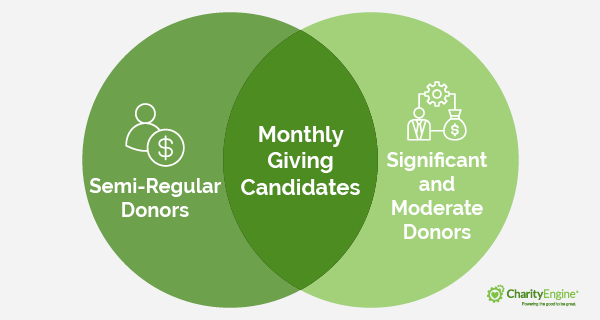Forming Long-Term Relationships with Supporters: 4 Benefits
While acquiring new supporters is important, there are many often overlooked benefits to forging long-term relationships with your existing donors.
Retaining supporters requires a mix of appreciation strategies, strong communication practices, and a continued dedication to fulfilling your mission. While this can take quite a bit of effort, in exchange, your nonprofit will begin forming relationships that can potentially span decades and can enjoy all of the benefits those long-term connections bring.
Let’s explore four benefits your nonprofits will experience.
1. Reliable support.
According to CharityEngine’s donation guide, “the health of a nonprofit can often be measured by sustainers.” This is because, with long-term donors, your nonprofit can look forward to reliable support on a routine basis. With recurring donations, your nonprofit can allocate your spending for future growth and have a cushion to fall back on if another fundraiser falls short.
The following giving traits may help your nonprofit identify potential recurring donors:

- Semi-Regular Donors. Those who give regularly but infrequently are ripe for a campaign encouraging them to become monthly donors, even if the donation amount decreases. You’d rather have $10 a month ($120 a year) than $25 given quarterly.
- Significant and Moderate Donors. These donors are often your major gift donors, without whom you might struggle to hit fundraising goals. When major gift donors engage in recurring gifts, it significantly strengthens your nonprofit.
Supporters can provide reliable help in other ways, such as campaign involvement and event attendance. Your long-term, dedicated supporters are often regular event attendees, and their presence at your events can help build a sense of community and make event management easier for your planning team. After all, events are at their most fun and successful when there are enough guests to participate in your activities, socialize with each other, and donate if it’s a fundraiser.
2. Increased value.
Few donors give major gifts to unfamiliar nonprofits. Long-term relationships can build the backbone of many nonprofits’ fundraising revenues by fostering recurring gifts.
Mid-level donors also tend to give more the longer their relationship with a nonprofit lasts. The longer a donor has been with your organization, the deeper their investment in your cause becomes and the more receptive they are to requests for increased support.
Here are a few ways you can earn more from your moderate donors:
- Increased gift amounts. Mid-level donors often increase their support throughout their relationship with a nonprofit. For example, a donor who gives $10 a month will likely be receptive to a request asking for $15 a month after they’ve been with your nonprofit for a significant amount of time.
- Participation in multiple fundraisers. Supporters familiar with your nonprofit and your usual fundraising methods may become interested in supporting you in other ways, like volunteering.
- Planned giving opportunities. Planned giving can help nonprofits gain significant funding, and long-term relationships are vital to its success. NPOInfo’s charitable giving statistics found that nonprofits often need decades-long relationships with donors to enroll in a planned giving program.
To track your supporters’ contributions over the years, note their donations and participation in their donor profiles in your CRM. This way, you’ll know exactly where each donor is in their donor journey and be able to ask for a donation increase at the right moment.
3. More networking opportunities.
Donors will feel more comfortable with your nonprofit after seeing an active community, which communicates the organization’s health and success. Your long-term supporters can also take active steps to grow your nonprofit network, such as:
- Word-of-mouth marketing. Long-term supporters are more likely to participate in word-of-mouth marketing, improving your nonprofit’s reputation while attracting new interest from their friends and family.
- Peer-to-peer campaigns. Peer-to-peer campaigns leverage your supporters’ relationships as they fundraise on behalf of your nonprofit. Then, rather than giving to an unfamiliar organization, new donors will give to a trusted friend or family member. Plus, if you invest in the right nonprofit fundraising software, you’ll have access to peer-to-peer fundraising and advocacy features that make it easy for supporters to spread the word.
- Prospective donors introductions. Major donors with whom you have a long-term connection can make introductions between you and their personal friends. Plus, if you’ve discovered a potential major donor through wealth screening, you can see if you have any donors with pre-existing relationships who would be willing to set up an introduction for you.
Remember that donors are most likely to help your nonprofit network when they have a strong relationship with your organization. Create a positive donor experience for all of your supporters to ensure that when they discuss your nonprofit with friends and family, they’ll have many positives to share.
4. Greater return on investment.
Encouraging your current donors to continue giving is ultimately more cost-effective than bringing in new donors. While you should continue your donor outreach efforts, don’t forget to steward your current donors.
Here are a few basic strategies for identifying and stewarding long-term supporters:
- Identify recurring giving candidates. Once you have basic information about a supporter, such as their contact and giving information, you can determine how likely they are to become a long-term supporter. If you aren’t completely sure about your donor’s eligibility for perks like corporate sponsorships or matching gifts, data appending services can help you fill in the gaps.
- Show appreciation. Thanking a donor immediately demonstrates your attention and appreciation. Donors who feel noticed are more likely to strengthen their support of your nonprofit and feel more engaged, which benefits your nonprofit in many ways.
- Collect supporter feedback. Understanding which stewardship strategies are working and which need to be tweaked can directly impact your fundraising. Plus, the sheer act of asking can help many supporters feel acknowledged and appreciated.
Compared to the marketing required to attract a new donor, these steps require few resources besides your time and a robust fundraising platform. While you should still work to attract new donors, these additional steps can help retain your current base and ensure you receive a return on your marketing investment.
Your supporters ensure your nonprofit can continue fulfilling its mission, and your long-term supporters have made the greatest investment in your cause. By maintaining these important connections, your nonprofit can look forward to reliable support, increased revenue, and opportunities to grow your organization. Use your donor management tools to look for ways to build and maintain these relationships with your long-term supporters.
Author: Leigh Kessler
Leigh Kessler is VP of Marketing and Communications at donor management software platform CharityEngine and a frequent speaker on branding, fundraising, data and technology. He is a former nationally touring headline comedian and has appeared on numerous TV shows including VH1’s “Best Week Ever”, CNN’s “Showbiz Tonight”, Discovery Channel & Sirius Radio. He has overseen and informed research and branding strategies for some of the most well known brands in America.




